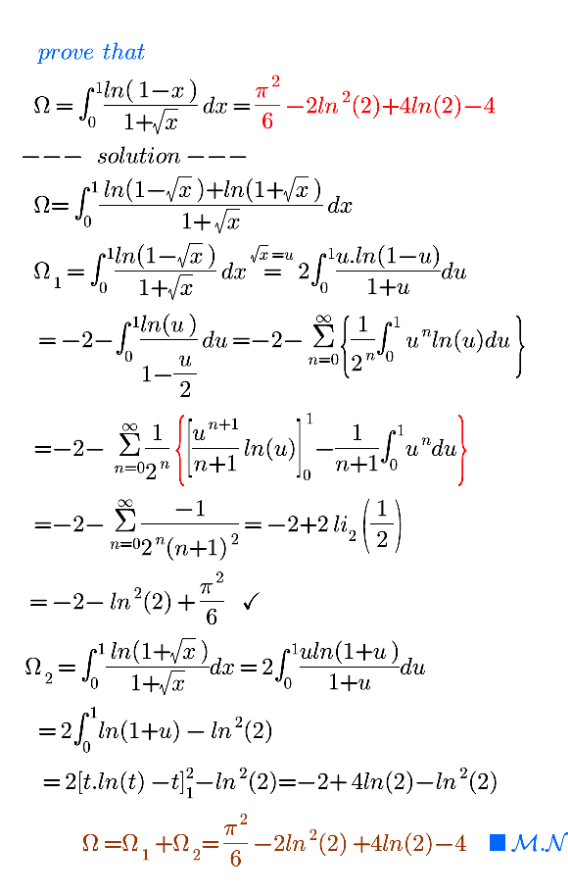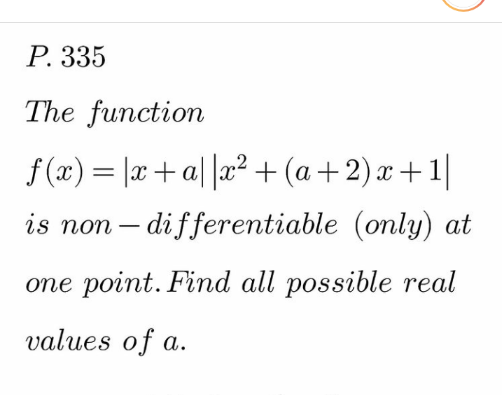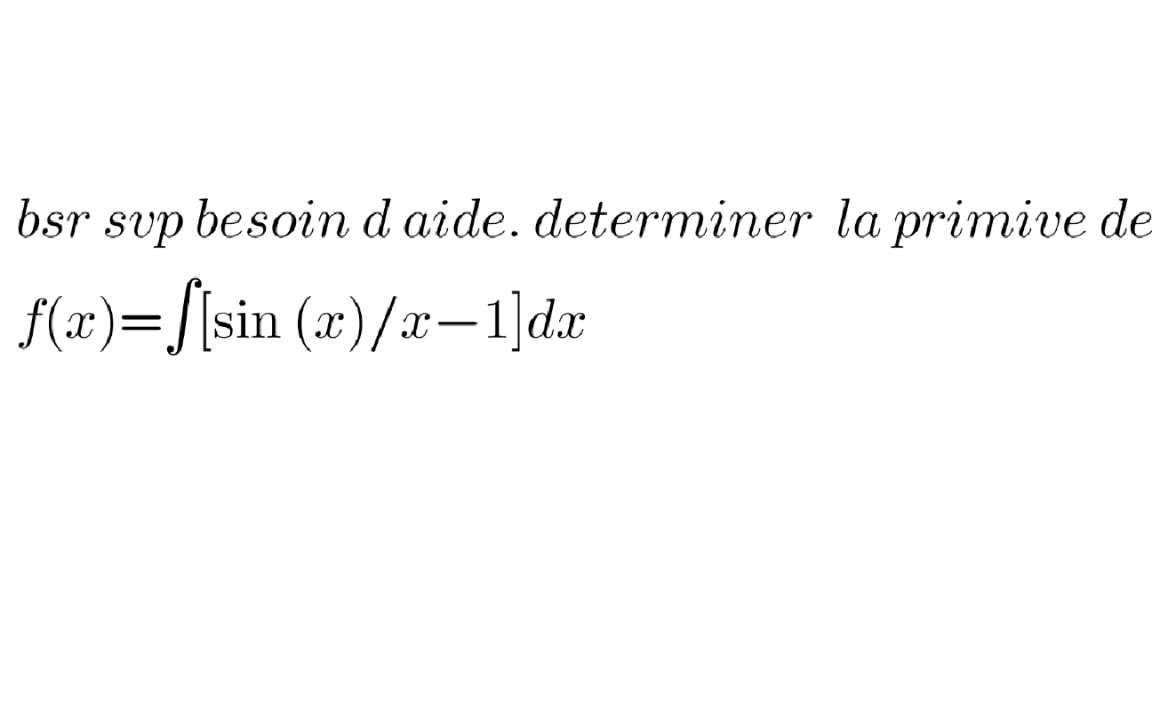
Question and Answers Forum
IntegrationQuestion and Answers: Page 45









|
Question and Answers Forum |
IntegrationQuestion and Answers: Page 45 |
| find ∫cos^3 x dx ? |

|
| prove that Σ_(n=0) ^∞ (((2n)!)/((n!)^2 4^n (2n+1)^4 ))=^? (π/(96))(12𝛇(3)+8ln^3 (2)+2π^2 ln(2)) −−−−−−−−by M.A |
| ∫_0 ^π (dt/(1−sina.cost))=??? , a∈]0,(π/2)[ |
| _0 ∫^2 ∣ x^2 −2x+1 ∣ dx =? |
| ∫_( 0) ^( 1) (dx/( (√x) ((x)^(1/3) +(x)^(1/4) )))=? |

|

|

|
| prove that ζ (0 )= ((−1)/2) |
| prove that : 1^∗ : Σ_(n=1) ^∞ (( ζ (2n )−1)/( 1+ n)) = (3/(2 )) − ln (π ) 2^( ∗∗) : Σ_(n=2) ^∞ (( (−1)^( n) ( ζ (n )−1 ))/(1 + n))=(3/2) +(γ/2) −((ln(8π))/2) 3^( ∗∗) : Σ_(n=1) ^∞ (( ζ (2n )−1)/(1+ 2n)) = (3/2) −((ln(4π))/2) −−−− m.n −−−− |
| ∫_0 ^( (π/2)) (( x^( 3) )/(sin^( 2) (x)))dx=^? (3/8) (π^( 2) ln(4)−7ζ(3)) |

|
| # Advanced Calculus # Let , f : R → Q is a continuous function . prove that ” f ” is a constant function . ■ m.n ∗ Adopted from mathematical analysis book ∗ −−−−−−−−−−−−−− |
| prove ( n∈ N ) 3(n+1) ∣ n^( 3) + (n+1)^( 3) + (n+2 )^( 3) |
| Ω = ∫_0 ^( (π/4)) cos (2x ).e^( ⌊ sin(x)+ cos(x) ⌋) dx ⌊ x ⌋= max { m ∈ Z ∣ m ≤ x } −−−− |
| nice integral ∫_0 ^1 (1/x)ln(Σ_(m=0) ^n x^m )dx=? −−−−−−−−−−−−−by MATH.AMIN |
| Question by M.N July Φ = ∫_0 ^( 1) ((ln(1 + x^4 + x^8 ))/x)dx Φ =^(x=x^(1/2) ) (1/2)∫_0 ^( 1) ((ln(1+x^2 +x^4 ))/x)dx Φ = (1/2)∫_0 ^( 1) ((ln(((1−x^2 )/(1−x^6 ))))/x)dx = (1/2)∫_0 ^( 1) ((ln(1−x^2 ))/x)dx − (1/2)∫_0 ^( 1) ((ln(1−x^6 ))/x)dx Φ = (1/2)(A − B) A =^(x=x^(1/2) ) (1/2)∫_0 ^( 1) ((ln(1−x))/x)dx = (1/2)Li_2 (1) B =^(x=x^(1/6) ) (1/6)∫_0 ^( 1) ((x^((1/6)−1) ln(1−x))/x^(1/6) )dx B = (1/6)∫_0 ^( 1) ((ln(1−x))/x)dx = (1/6)Li_2 (1) Φ = (1/2)((1/2)Li_2 (1)−(1/6)Li_2 (1)) = (1/6)Li_2 (1) 𝚽 = ((𝛇(2))/3) ▲▲▲ |

|

|
| Let , f : [ 0 , 1 ] → R is a continuous function , prove that : lim_( n→ ∞) ∫_0 ^( 1) (( n f(x))/(1+ n^2 x^( 2) )) dx = (π/2) f (0 ) −−− proof −−− S_( n) = [∫_(0 ) ^( (1/( (√n)))) (( n. f(x))/(1 + n^( 2) x^( 2) )) dx =Ω_( n) ]+[ ∫_(1/( (√n))) ^( 1) ((n.f (x))/(1 + n^( 2) x^( 2) )) dx = Φ_( n) ] Ω_( n) =_(∃ t_( n) ∈ ( 0 , (1/( (√n) )) )) ^(MeanValueTheorem( first)) f (t_( n) )∫_(0 ) ^( (1/( (√n)))) (( n)/(1 + n^( 2) x^( 2) ))dx = f ( t_( n) ) ( tan^( −1) ( (√n) )) lim_( n→∞) (Ω_( n) ) = (π/2) f (lim_( n→∞) ( t_( n) ) ) = (π/2) f (0 ) Φ_( n) = ∫_(1/( (√n))) ^( 1) (( n. f(x) )/(1 + n^( 2) x^( 2) )) dx ⇒_(∃ M >0) ^(f is bounded) ∣ Φ_( n) ∣ ≤ M.∫_(1/( (√n))) ^( 1) (n/(1+ n^( 2) x^( 2) )) dx ⇒ ∣ Φ_( n) ∣ ≤ M . ( tan^( −1) ( n )− tan^( −1) ( (√n) )) lim_( n→ ∞) ∣ Φ_( n) ∣ = 0 ⇒ lim_( n→∞) Φ_( n) =0 ∴ lim_( n→ ∞) ( S_( n) ) = (π/2) f (0 ) ■ m.n |
| lim_( n→ ∞) ∫_0 ^( 1) (( n . e^( 1− x^( 2) ) )/( 1 + n^( 2) x^( 2) )) dx =? −−−−−− |

|

|
| Ω= Σ_(n=1) ^∞ (( ψ^((2)) ( 1+ n ))/( n)) = ? −−− m.n −−− |
| ∫_0 ^( 1) (( ln( 1− x ).ln(x ) )/x^( (3/2)) )dx=^? π^( 2) −8ln(2 ) −−− m.n −−− |